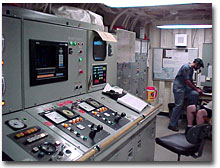A sweatshirt is a necessity on board a ship. Most of the rooms on the ship are kept very cool. Walk through the door on the side of the passage and you have entered a whole new climate zone. You have entered the engine room.

The door itself is rather intimidating. "Danger! High Noise Level. Wear Ear Protection." "Caution! Wear Eye Protection." "When Alarm Sounds, Vacate at Once!" Open the door and you are overcome by the piercing whine of the engines.
But one of the engineers will ease your trepidation by handing you a pair of ear phones and cheerfully leading you down the stairs.
Below are the ship’s six engines. The forward three, which are 2,100 horse power each, run the ship’s motors. The rear three, which are half the size, run the ship’s services such as lights, computers, kitchen appliances, washing machines, and air circulation. In a pinch, they can also run the ship's motors. Not all of the engines run at once, however. Typically, only one of the large engines runs the propulsion when the ship is towing an instrument over the side, two if the ship is in transit, and only one of the smaller engines runs all of the ship’s services.
Across the walkway above the engines is a small room (the control room) where you can take off the ear phones. On one side, windows look out over the engines. On the other side, computer monitors, buttons, and gauges cover the wall. The engineers can start or stop each engine simply by pushing a button. One screen shows which engines are on line and where the power is being directed. A panel shows the shaft and propeller speed of the motors and the direction they are pushing the ship. Another screen provides information on all aspects of how the engines are performing, from the oil pressure to the exhaust temperature. If a problem occurs, an alarm will sound. The engineer can then scroll through the screen, identify where the problem is, and if necessary shut down the engine.
Obviously one of the greatest concerns is fire. The ship can hold up to 300,000 gallons of fuel, so it is easy to imagine how bad things could get. Should a fire break out, the first option would be to fight the fire with hoses. If the fire got out of hand in the engine room, the engineer could seal off the fire doors and as a last resort flood the area with either foam or halon gas. The halon gas would suffocate the fire but would also suffocate anybody trapped inside.

Put on your earphones, descend a flight of stairs and you are amongst the engines. Each engine turns a generator that produces up to 600 volts of electricity. A giant switchboard directs the power to motors or the ship’s services as needed. The ship has three motors. In the back, there are two propeller drives called Z-drives. These are the main motors that propel the ship forward. The ship does not have a rudder. Instead, the shafts of the Z-drives can rotate the propellers 360 degrees and can therefore steer the ship in any direction. The third engine, called a bow thruster, sits in the front of the boat. It is used exclusively to maneuver the ship, although on a calm day, it can pull the ship forward in a pinch. The bow thruster takes in water then pushes the water out through a diffuser. Just as the propellers of the Z-drives can rotate in any direction, the diffuser can push the water out in any direction and therefore can push the bow in any direction. The combination of the two Z-drives and the bow t ruster enable the officers on the bridge to maneuver or pivot the ship every which way.
A computer on the bridge controls all three motors and keeps the ship on course. If the computer fails, the engineer could manually control the ship’s course from the control room.
The officers on the bridge must determine the safest, most efficient route to take. First they decide which direction to point the ship. This is called the heading. But the ship does not necessarily move in the direction it is pointing. Depending on the direction and strength of the wind in the current, the officers may decide to guide the ship at an angle or even sideways. This maneuver is called "crabbing." By choosing the right heading, the officers reduce the amount of work the engines must exert.
The officer on the bridge then enters the heading, destination, and desired speed into the computer. From then on, the computer, not the officer, keeps the ship on course.